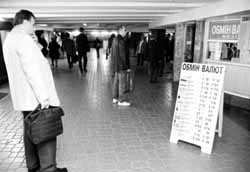Ukrainian Strike on Dollar

After the World Trade Center rubble had almost buried faith in a stable dollar, the greenback took yet another blow. Although the European Central Bank intervened in the stock market immediately after the terrorist act to back the dollar, the Europeans still stand by their decision to put into circulation on January 1, 2002, the euro, which has considerably strengthened of late. On September 21, the official exchange rate of the non-circulating euro was $1.075. In addition, expected US military operations against the terrorists will submerge the dollar even more.
The transition to euro banknotes is “quite an insignificant problem” for this country, Serhiy Yaremenko, director of the NBU foreign currency regulation department, claimed on September 20 after a routine meeting of the representatives of 28 leading Ukrainian and European banks devoted to turning the euro into real money. Failing to announce the exact amount of European Union countries’ hard currency now kept by the population, he was still sure that our citizens are so well-informed that this will help avoid unnecessary agitation over the exchange of German marks for euros. In this connection, answering The Day correspondent’s question, Mr. Yaremenko emphasized that “to support the DM and other currencies, we have introduced a cross-rate which will keep commercial banks from manipulating the margin.”
However, the euro may also strike at the dollar in Ukraine. Although this could be pure coincidence, the dollar rate on the cash market dropped again by several points after the media quoted Minister of Finance Ihor Mitiukov as saying that a part of this country’s gold and hard-currency reserves will perhaps be converted into the common European currency. On September 20, Mr. Yaremenko was groping for words to appease the dollar, saying that forming euro-based reserves is an “unfounded” approach. “Almost all foreign liabilities of the NBU and Ukraine are expressed in dollars,” he said.
Meanwhile, the official dollar rate, set by the National Bank on the non-cash currency market, remains practically unchanged. It will also be recalled that the NBU is still pursuing a consistent policy of boosting its gold and hard currency reserves. In simple words, the NBU is buying the banks’ surplus hard currency under guarantee. “Thus, it is unfounded to artificially underrate the dollar, Mr. Yaremenko thinks (this underrating may have been planned, for the margin arising out of the difference between the non-cash and cash market rates contributes to the revenues of commercial banks — Author).
Although the first dollar-related panic was calmed, and despite the pacifying statements of high Ukrainian officials, our citizens fear losing dollars as they did Soviet rubles in the Saving Bank. These quite easy to understand doubts are being further stirred up by the groundless reports of some media about a US economic crisis, as well as by, so to speak, street-corner talk about the buck inevitably going bust. This so far subdued panic is, of course, providing fertile ground for all kinds of speculation.
Mr. Yaremenko told The Day that “there are three very interesting months ahead. It is too early to make any forecasts today. In addition, to make them, one must duly assess the level of export-import relations between the European countries and the US, the degree of their economies’ integration, further US policies on the world arena, etc.” Yet, it is obvious that the people who keep their savings in dollars feel uneasy over the US currency’s uncertain future. On the other hand, as Nadiya Kholodniuk, chief of the deposit operations methods and policies department at VaBank, claims, “there is no tendency toward the outflow of dollar deposits in connection with the terrorist acts. Just the contrary, deposits are on the rise. Interest rates (which also speaks volumes — Author) have remained unchanged.”
Yet, the question of a saving alternative also remains open. The hryvnia which, according to NBU Governor Volodymyr Stelmakh, “has become one of Europe’s most stable currencies in the past six months,” has not yet been accepted in mass consciousness as a means of saving. The European currencies? On the one hand, they are soon to be supplanted by the euro, and, on the other hand, the leading European countries can also be drawn into the military conflict with all that this implies for the European currency. No wonder, in this situation international markets have seen a leap in the price of gold, a more stable valuable, up to an average $1 per gram, with further increases to follow. But, as The Day was told by the press service of Brokbiznesbank (which, incidentally, decided, following the US events, to enter the precious metals market), the culture of purchase and sale of gold still is on a very low level in this country: a mere 0.01% of deposits have been made in precious metals.






